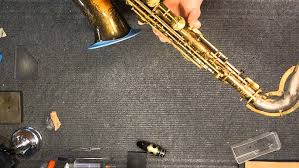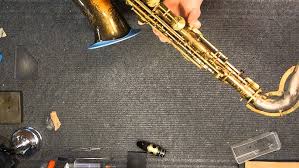Saxophone Hub
Why Your Saxophone Is Leaking and How to Fix It

Introduction
A saxophone leak can significantly impact your playing experience, leading to weak or inconsistent sound, especially in the lower register. Leaks occur when air escapes from places it shouldn’t, which prevents a clean, powerful tone. Understanding the causes of leaks and knowing how to fix them can help you keep your saxophone in excellent playing condition. This guide explains how to identify leaks, discusses common causes, and explores both DIY and professional repair options.
1. How to Identify a Leak in Your Saxophone
Signs of a Leak
Leaks can affect different aspects of your saxophone’s sound quality and playability. Here are some common signs that your saxophone may have a leak:
- Weak Sound: If the sound is airy or weak, especially in the lower notes, there may be a leak causing air to escape.
- Difficulty with Low Notes: Leaks often make it difficult to play low notes, as these require a strong seal to produce a full sound.
- Air Escaping from Pads: If you feel air escaping from any pad when keys are pressed, this is a likely indicator of a leak.
Leak Testing Methods
If you suspect a leak, try one of these simple leak detection methods:
- Paper Test: Place a small piece of paper between the pad and tone hole, then press down on the key. If the paper slides out easily, there’s likely a leak.
- Leak Light Test: Using a leak light (a small light placed inside the saxophone body) can reveal where light escapes, indicating areas where air is leaking.
2. Common Causes of Saxophone Leaks
Worn Pads
One of the most common causes of saxophone leaks is worn or damaged pads. Pads are made of leather and felt, which compress and wear out over time. When they don’t seal properly, air can escape through gaps, weakening the sound. Regular pad inspection helps prevent this issue, and replacing worn pads is a common repair for leaks.
Misaligned Keys
Misaligned keys can also cause leaks by preventing pads from covering tone holes fully. If the key height or position is off, it won’t seal the tone hole correctly, allowing air to escape. Misalignment can occur from regular use or accidental bumps and often requires professional adjustment.
Loose Screws or Springs
Over time, screws and springs can loosen, affecting the way keys function. Loose screws can lead to shifting keys, which disrupts the pad seal, while weak springs may prevent keys from pressing down fully. Regularly checking screws and springs helps prevent leaks caused by loose parts.
Cracked or Damaged Corks
Leaks can also stem from worn or cracked corks on the neck or other key areas. Corks play an important role in sealing joints and key mechanisms, and if they’re damaged, air can escape. Replacing damaged corks restores a firm seal and prevents air from leaking.
3. DIY Leak Fixes for Minor Issues
Tightening Screws
If you notice loose screws, gently tighten them with a screwdriver to secure the keys. Be careful not to overtighten, as this can affect key movement. Tightened screws help prevent keys from shifting, which improves the pad seal.
Cleaning and Adjusting Pads
If dust or dirt is causing a poor seal, gently wipe the pads with a dry, soft cloth. Cleaning pads removes debris that may impact sealing quality. For minor alignment issues, try pressing down on the key a few times to adjust the pad position. Avoid pressing too hard to prevent damage.
Reed and Mouthpiece Adjustment
Sometimes, minor air loss may stem from the mouthpiece or reed setup. Ensure the reed is positioned correctly, with the mouthpiece and neck fitting snugly. A properly adjusted reed and mouthpiece setup can prevent unnecessary air loss.
4. Professional Leak Repairs
Pad Replacement and Seating
If pads are worn, damaged, or poorly seated, a professional technician can replace them to restore a secure seal. Professionals use precise tools to seat pads accurately, ensuring each one forms a perfect seal with its tone hole. This process improves sound quality and reduces air leaks.
Key Alignment Adjustments
For misaligned keys, professional adjustments ensure each key closes fully and evenly over its corresponding tone hole. Using specialized tools, technicians realign keys to create a firm seal, eliminating air leaks and improving playability.
Detailed Leak Testing and Correction
Technicians use leak lights, feeler gauges, and other specialized tools to identify even the smallest leaks. By testing each pad and tone hole thoroughly, they can diagnose and correct multiple leaks, ensuring your saxophone performs at its best.
5. How Horns Engineer Can Help with Leak Repairs
Expert Leak Diagnosis and Repairs
At Horns Engineer, we specialize in diagnosing and repairing saxophone leaks with precision and care. Our experienced technicians use quality materials and professional techniques to ensure a firm seal on every pad and tone hole. From minor adjustments to full pad replacements, we provide services tailored to address any leaks affecting your saxophone’s performance.
Satisfaction Guarantee and First-Time Discounts
We prioritize customer satisfaction with free consultations and discounts for first-time clients. If you’re dealing with a leak or need maintenance, contact Horns Engineer to keep your saxophone in peak condition and enjoy clear, consistent sound.
Conclusion
Saxophone leaks can affect sound quality and playability, but identifying and repairing them can restore your instrument’s performance. From minor adjustments to professional repairs, there are options to address leaks effectively. For expert leak diagnosis and repair, contact Horns Engineer on WhatsApp at +234-813-540-4292 or follow us on social media at Horns Engineer aka Hornsify. Let us help you keep your saxophone sounding its best.
FAQs
1. How do I know if my saxophone has a leak?
Common signs of a leak include a weak or airy sound, difficulty playing low notes, and air escaping from the pads. You can also try a paper test or use a leak light to check for leaks.
2. What causes a saxophone to develop leaks?
Saxophone leaks can be caused by worn pads, misaligned keys, loose screws or springs, and cracked corks. Regular use and environmental factors also contribute to leaks over time.
3. Can I fix a saxophone leak myself?
For minor issues like tightening screws or cleaning pads, DIY fixes can help. However, major repairs, such as pad replacement or key alignment, are best handled by a professional technician to ensure a proper seal.
4. How much does it cost to repair a saxophone leak?
The cost of repairing a saxophone leak depends on the severity of the issue. Minor adjustments are typically affordable, while pad replacement and key realignment may cost more. A technician can provide an estimate after assessing the saxophone.
5. Why choose Horns Engineer for saxophone leak repairs?
Horns Engineer offers professional leak diagnosis and repair services, using specialized tools to ensure precise pad seals and key alignment. We provide free consultations, satisfaction guarantees, and first-time discounts for new clients.



